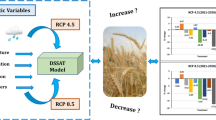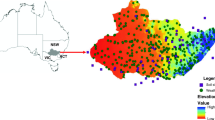Abstract
In countries with scarce water resources, modeling the impacts of climate change on agricultural crops is highly important to assess levels of adverse impacts and to put future changes within the context of planning. In this study, climate change impacts on grain and biological yields of barley were assessed using data for three sites, representing Mediterranean environments in Jordan. Historical climatic and crop data were to calibrate DSSAT crop model to simulate grain and biological yields. Future climate data of daily air temperature and precipitation for the two future periods of 2030–2050 and 2080–2100, under the representative concentration pathway (RCP), were obtained from the downscaled NASA Earth Exchange Global Daily Downscaled Projections (NEX-GDDP) of General Circulation Models (GCMs) simulations. The Decision Support System for Agrotechnology Transfer (DSSAT) model was then used to simulate barley yield under RCP4.5 and RCP8.5 scenarios for the two future periods. The NEX-GDDP future climate projections showed that climate changes would be extreme in terms of declined precipitation and increased air temperature. On average, minimum air temperature would increase by 2.0–4.8 °C while maximum air temperature would increase by 2.4–5.4 °C. These changes would result in severe reductions in barley yield, as shown by the outputs from DSSAT model, except for the site of Madaba under the scenario of RCP8.5 for 2030–2050. The average reduction in grain yield would be 9–30% during 2030–2050 and 5–19% during 2080–2100. The average reduction in biological yield would be and 8–31% during 2030–2050 and 6–19% during 2080–2100. Results also showed significant correlations between DSSAT observed and simulated yield, with relatively high R2 values and low root mean square error (RMSE). Therefore, the trends of climate change would have an adverse impact on rainfed crops in Mediterranean environments similar to the sites included in this study.







Similar content being viewed by others
References
Abdul-Rahman M (2005) A comparison of forage and grain production of triticale with wheat and barley cultivars under dryland conditions in Jordan. Dirasat Agric Sci 32(1):123–133
Abu Hammad A (1993) Effect of different crop rotations, tillage-residue management on soil moisture storage, soil physical properties, and yield in rainfed areas. Unpublished M.Sc. Thesis, The University of Jordan, Amman, Jordan
Abu Taleb KAA, Mohammed AHES, Ahmed MHM (2018) Climate change impacts, vulnerabilities and adaption measures for Egypt’s Nile Delta. Earth Syst Environ. https://doi.org/10.1007/s41748-018-0047-9
Ahmadalipour A, Moradkhani H (2018) Escalating heat-stress mortality risk due to global warming in the Middle East and North Africa (MENA). Environ Int 117:215–225. https://doi.org/10.1016/j.envint.2018.05.014
Al-Bakri JT (2008) Final Report: Agricultural Sector, Project Enabling Activities for the Preparation of Jordan’s Second National Communication to the UNFCCC. A Report for MoEnv and UNFCCC, Ministry of Environment, Amman, Jordan
Al-Bakri JT, Suleiman A, Abdulla F, Ayad J (2011) Potential impacts of climate change on the rainfed agriculture of a semi-arid basin in Jordan. Phys Chem Earth 36(5–6):125–134
Al-Bakri JT, Salahat M, Suleiman A, Suifan M, Hamdan MR, Khresat S, Kandakji T (2013) Impact of climate and land use changes on water and food security in Jordan: implications for transcending “The tragedy of the commons.” Sustainability 5(2):724–748
Al-Bakri JT, AlNaimat MJ, Al-Karablieh E, Qaryouti EA (2019) Assessment of combined drought index and mapping of drought vulnerability in Jordan. Int J Eng Res Appl 9(3):59–68
Al-Kharabsheh HM (2017) Simulation and adaptation measures of the impact of climate change on barley productivity in Jordan. Unpublished Ph.D. Thesis, The University of Jordan, Amman, Jordan
Almazroui M (2019) Temperature changes over the CORDEX-MENA domain in the 21st century using CMIP5 data downscaled with RegCM4: a focus on the Arabian Peninsula. Adv Meteorol. https://doi.org/10.1155/2019/5395676
Almazroui M, Islam MN, Saeed S et al (2020) Future changes in climate over the Arabian Peninsula based on CMIP6 multimodel simulations. Earth Syst Environ 4:611–630. https://doi.org/10.1007/s41748-020-00183-5
Al-Qinna MI, Hammouri NA, Obeidat MM, Ahmad FY (2011) Drought analysis in Jordan under current and future climates. Clim Change 106:421–440. https://doi.org/10.1007/s10584-010-9954-y
Araro K, Legesse SA, Meshesha DT (2020) Climate change and variability impacts on rural livelihoods and adaptation strategies in Southern Ethiopia. Earth Syst Environ. https://doi.org/10.1007/s41748-019-00134-9
Battikhi AM, Suifan MS, Al-Bakri JT (1998) Effect of tillage and plant residue management practices on some physical properties of vertisols. Dirasat Agric Sci 25(3):362–374
Cammarano D, Ceccarelli S, Grando S (2019) The impact of climate change on barley yield in the Mediterranean basin. Eur J Agron 106:1–11. https://doi.org/10.1016/j.eja.2019.03.002
Collins M, Knutti R, Arblaster J, Dufresne JL, Fichefet T, Friedlingstein P, Gao X, Gutowski WJ, Johns T, Krinner G, Shongwe M (2013) The new concentration driven RCP scenarios, and their extensions, in: Chapter 12, Section 12.3.1.3. Long-term climate change: projections, commitments and irreversibility. In Climate Change 2013-The Physical Science Basis: Contribution of Working Group I to the Fifth Assessment Report of the Intergovernmental Panel on Climate Change 2013. Cambridge University Press, pp 1029–1136
Cook BI, Anchukaitis KJ, Touchan R, Meko DM, Cook ER (2016) Spatiotemporal drought variability in the Mediterranean over the last 900 years. J Geophys Res Atmos. https://doi.org/10.1002/2015JD023929
De Castro LN (2007) Fundamentals of natural computing: an overview. Phys Life Rev 4:1–36. https://doi.org/10.1016/j.plrev.2006.10.002
DOS [Department of Statistics] (2019) Interactive database from Department of Statistics. Amman. http://dosweb.dos.gov.jo/
Driouech F, ElRhaz K, Moufouma-Okia W, Arjdal K, Balhane S (2020) Assessing future changes of climate extreme events in the CORDEX-MENA region using regional climate model ALADIN-climate. Earth Systems and Environment 4(3):477–492. https://doi.org/10.1007/s41748-020-00169-3
Haddad N, Singh M, Mamdouh Q (2005) On-farm evaluation of improved barley production technology packages in Jordan. Jordan J Agric Sci 1(1):1
Hay RKM, Porter JR (2006) The physiology of crop yield, 2nd edn. Blackwell Publishing Ltd, Oxford, p 328
Hoogenboom G, Porter CH, Shelia V, Boote KJ, Singh U, White JW, Hunt LA, Ogoshi R, Lizaso JI, Koo J, Asseng S, Singels A, Moreno LP, Jones JW (2019) Decision Support System for Agrotechnology Transfer (DSSAT) Version 4.7.5. DSSAT Foundation, Gainesville, Florida, USA. https://DSSAT.net
ICARDA (2001) The development of integrated crop/livestock production in the low rainfall areas of West Asia and North Africa (Mashreq/Maghreb Project). Annual Report for 2000/2001 Season, ICARDA and IFPRI
ICARDA (2002) The development of integrated crop/livestock production in the low rainfall areas of West Asia and North Africa. Annual Report for 2000/2001 Season, ICARDA and IFPRI
IPCC (2018) Summary for policymakers. In: Masson-Delmotte V, Zhai P, Pörtner H-O, Roberts D et al (eds) Global warming of 1.5 °C: an IPCC special report on the impacts of global warming of 1.5 °C above pre-industrial levels and related global greenhouse gas emission pathways, in the context of strengthening the global response to the threat of climate change, sustainable development, and efforts to eradicate poverty. World Meteorological Organization, Geneva, p 32
IPCC (2014) Climate change 2014: synthesis report. In: Core Writing Team, Pachauri RK, Meyer LA (eds) Contribution of Working Groups I, II and III to the Fifth Assessment Report of the Intergovernmental Panel on Climate Change. IPCC, Geneva, p 151
Kamworapan S, Surussavadee C (2019) Evaluation of CMIP5 global climate models for simulating climatological temperature and precipitation for Southeast Asia. Adv Meteorol 2019:1–8. https://doi.org/10.1155/2019/1067365
Kelley CP, Mohtadi S, Cane MA, Seager R, Kushnir Y (2015) Climate change in the Fertile Crescent and implications of the recent Syrian drought. Proc Natl Acad Sci 112(11):3241–3246. https://doi.org/10.1073/pnas.1421533112
Kuwayama Y, Thompson A, Bernknopf R, Zaitchik B, Vail P (2019) Estimating the impact of drought on agriculture using the U.S. Drought Monitor. Am J Agric Econ. https://doi.org/10.1093/ajae/aay037
Lehman A, O’Rourke N, Hatcher L, Stepanski E (2013) JMP for basic univariate and multivariate statistics: methods for researchers and social scientists. SAS Institute, Cary
Mavromatis T, Boote KJ, Jones JW, Irmak A, Shinde D, Hoogenboom G (2001) Developing genetic coefficients for crop simulation models with data from crop performance trials. Crop Sci 41:40–51
Meinshausen M, Smith SJ, Calvin K, Daniel JS, Kainuma ML, Lamarque JF, Matsumoto K, Montzka SA, Raper SC, Riahi K, Thomson AG (2011) The RCP greenhouse gas concentrations and their extensions from 1765 to 2300. Clim Change 109(1):213–241. https://doi.org/10.1007/s10584-011-0156-z
MoA [Ministry of Agriculture] (1993) The soils of Jordan: Level 1 (Reconnaissance Survey), Report of the National Soil Map and Land Use Project, vol 1. Ministry of Agriculture, Amman
MoA [Ministry of Agriculture] (1995a) The soils of Jordan: Level 2 (Semi Detailed Studies), Report of the National Soil Map and Land Use Project, vol 3. Ministry of Agriculture, Amman
MoA [Ministry of Agriculture] (1995b) The soils of Jordan: Level 3 (Detailed Studies), Report of the National Soil Map and Land Use Project, vol 5. Ministry of Agriculture, Amman
MWI [Ministry of Water and Irrigation] (2016) Climate change policy for a resilient water sector. Ministry of Water and Irrigation, Amman
Ongoma V, Chen H, Gao C (2019) Evaluation of CMIP5 twentieth century rainfall simulation over the equatorial East Africa. Theor Appl Climatol 135:893–910. https://doi.org/10.1007/s00704-018-2392-x
Peng B, Guan K, Tang J, Ainsworth EA, Asseng S, Bernacchi CJ, Cooper M, Delucia EH, Elliott JW, Ewert F, Grant RF (2020) Towards a multiscale crop modelling framework for climate change adaptation assessment. Nat Plants 6(4):338–348. https://doi.org/10.1038/s41477-020-0625-3
Prasanna V (2015) Regional climate change scenarios over South Asia in the CMIP5 coupled climate model simulations. Meteorol Atmos Phys 127:561–578. https://doi.org/10.1007/s00703-015-0379-z
Raghavan SV, Hur J, Liong SY (2018) Evaluations of NASA NEX-GDDP data over Southeast Asia: present and future climates. Clim Change 148:503–518. https://doi.org/10.1007/s10584-018-2213-3
Taylor KE, Stoufer RJ, Meehl GA (2012) An overview of CMIP5 and the experiment design. Bull Am Meteorol Soc 93(4):485–498. https://doi.org/10.1175/BAMS-D-11-00094.1
Thrasher B, Maurer EP, McKellar C, Duffy PB (2012) Technical note: bias correcting climate model simulated daily temperature extremes with quantile mapping. Hydrol Earth Syst Sci 16:3309–3314. https://doi.org/10.5194/hess-16-3309-2012
Trenberth KE et al (2014) Global warming and changes in drought. Nat Clim Chang 4:17–22. https://doi.org/10.1038/nclimate2067
Voldoire A, Sanchez-Gomez E, y Mélia DS, Decharme B, Cassou C, Sénési S, Valcke S, Beau I, Alias A, Chevallier M, Déqué M (2013) The CNRM-CM5.1 global climate model: description and basic evaluation. Clim Dyn 40(9):2091–2121. https://doi.org/10.1007/s00382-011-1259-y
Waha K, Krummenauer L, Adams S, Aich V, Baarsch F, Coumou D, Fader M, Hoff H, Jobbins G, Marcus R, Mengel M (2017) Climate change impacts in the Middle East and Northern Africa (MENA) region and their implications for vulnerable population groups. Reg Environ Change 17(6):1623–1638. https://doi.org/10.1007/s10113-017-1144-2
Wood AW, Maurer EP, Kumar A, Lettenmaier DP (2002) Long-range experimental hydrologic forecasting for the eastern United States. J Geophys Res Atmos. https://doi.org/10.1029/2001JD000659
Wood AW, Leung LR, Sridhar V, Lettenmaier DP (2004) Hydrologic implications of dynamical and statistical approaches to downscaling climate model outputs. Clim Change 62:189–216. https://doi.org/10.1023/B:CLIM.0000013685.99609.9e
Acknowledgements
Climate scenarios used were from the NEX-GDDP dataset, prepared by the Climate Analytics Group and NASA Ames Research Center using the NASA Earth Exchange, and distributed by the NASA Center for Climate Simulation (NCCS). This publication was made possible through the support of the Office of Science and Technology, Bureau for the Middle East, U.S. Agency for International Development, under the terms of Award No. AID-ME-IO-15-003. The opinions expressed in this publication are those of the authors and do not necessarily reflect the views of the U.S. Agency for International Development or the United States government. The authors also acknowledge the International Center for Biosaline Agriculture (ICBA), Dubai, UAE and the team of Regional Drought Management System (RDMS) Project for (MENA).
Author information
Authors and Affiliations
Corresponding author
Ethics declarations
Conflict of interest
On behalf of all authors, the corresponding author states that there is no conflict of interest.
Rights and permissions
About this article
Cite this article
Al-Bakri, J., Farhan, I., Al-Qinna, M. et al. Assessment of Climate Changes and Their Impact on Barley Yield in Mediterranean Environment Using NEX-GDDP Downscaled GCMs and DSSAT. Earth Syst Environ 5, 751–766 (2021). https://doi.org/10.1007/s41748-021-00238-1
Received:
Revised:
Accepted:
Published:
Issue Date:
DOI: https://doi.org/10.1007/s41748-021-00238-1




